
 |
 |
 |
 |
 |
 |
 |
email: roadarch@outlook.com |
 |
| Federal Electric Sectional Signs (page 1) |
(hit "refresh" to get the most recent version of this page; click on photos for larger images)
| The photos and links at this page are meant to accompany an article that I wrote for the Society for Commercial Archeology's Journal. |
|
American streets were transformed in the early 1900s by the proliferation of electric signs. Miraculously, a number of these signs still survive and remain on public display.
In 1882, the first electric sign with incandescent bulbs appeared at the International Electrical Exposition in London, England. This sign was created by William J. Hammer, an assistant of Thomas Edison. The bulb-filled letters spelled out "EDISON" and a manually operated giant switch created flashing action. While Edison did not invent the light bulb, he did create the first commercially practical design which was patented in 1880. Initially, these bulbs were too large and expensive for commercial signs. However, by the 1890s, smaller bulbs were developed and the cost of electricity had gone down. A motor was also developed during this time to create flashing signs. The first electric "spectacular" sign was erected in 1892 in New York City. It was installed on the side of a building on the site of today’s Flatiron Building. The sign was 50 feet tall and 80 feet wide. It held 1,457 bulbs of different colors and had a hand-operated flashing mechanism. The sign operated from dusk until 11 o'clock each night. It read "Buy Homes on Long Island, Swept by Ocean Breezes." It also advertised for two theatres, Gilmore's Band, and Brock's Fireworks. This sign was the precursor to the countless electric signs that would line Broadway and earn it the nickname of "The Great White Way" by the late 1890s. These early electric signs were a distinctly American phenomenon. By 1906, there were an estimated 75,000 electric signs in the United States. Businesses recognized the importance of 24-hour advertising. Cities enthusiastically welcomed these signs as a public service since they promoted safety by illuminating sidewalks and roadways at night. The earliest and largest producer of electric signs was the Federal Electric Company which was established in Chicago in 1901. Federal Electric was an off-shoot of the Commonwealth Edison Company. The company’s earliest signs were framed panels. The central panels were illuminated with bulbs installed in sockets around the frames. Business owners could choose from generic text such as "Drugs", "Hotel", "Cafe", "Cigars", "Lunch", or "Garage". Custom panels could also be made to display the name of the business. It is believed that the frames were always white while the center panels were consistently dark blue with white letters. These frame signs were the most popular type of electric signs until around 1910. |
| Old Barbee Whiskey private collection |
Jeffcoat's Photography Studio Abilene, KS |
advertisement Druggists Circular magazine September 1920 issue |
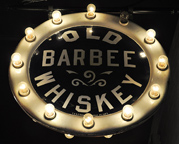 |
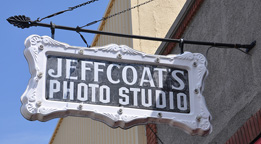 |
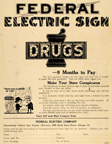 |
|
This Old Barbee Whiskey frame sign is probably from the 1900s or 1910s. The company was established in Louisville, Kentucky in 1892 and folded in 1920 during Prohibition. These round production signs were commonly used by the brewery trade. This sign was installed at the American Sign Museum but is now in a private collection.
Of these early electric signs, the rectangular design like that used for Jeffcoat's Photography Studio was the most common. Paul H. Jeffcoat opened his photography studio in Abilene in 1921. This sign was hung when the business moved to its current location in 1925. The shop was run by family members until it closed in 2007. Since 2008, the space has housed the Jeffcoat Photography Studio Museum. After nearly ninety years, the sign's dark blue center panel had faded a bit and the bulbs were no longer lit. This photo is from 2010. By 2017, the panel had been repainted and now reads "Jeffcoat Photo Museum" and the bulbs are lit. This may be the only example of Federal Electric's framed signs still at its original location. There are a few other surviving signs like this in Hendersonville, NC, Indianapolis, IN, and at the American Sign Museum in Cincinnati, OH. [map] |
|
Sectional Signs. In the early 1900s, Federal Electric and other sign companies began producing sign panels with bulbs installed directly over the letters. This improved the readability of these electric signs at night. This design change was carried to the next level in 1903 when Federal Electric developed and patented its modular letter signs. The company called them "sectional lamp letter signs." The signs were composed of mass-produced, individual 16-inch-tall letter panels. These "off-the-shelf" letters could spell out the business name or more generic text. This concept made sign construction faster and less costly. To further entice customers, Federal Electric offered these signs on installment payment plans or leased the signs to customers. When businesses closed, these modular letters could be removed by the sign shop and recycled to create another sign. The letters could also be animated with a flashing mechanism if the customer desired it. By the 1920s, Federal Electric had offices in all the major cities in the United States and was producing thousands of these sectional signs. Today, there are only about a dozen of them still hanging.
These letter panels, like the earlier frame signs, were produced from porcelain enameled steel. This material was superior to earlier painted metal signs which were prone to rust and required repainting every few years. Porcelain panels are virtually indestructible and a quick rubdown with soap and water keeps them looking brand new. Porcelain enamel continued to be the preferred material for neon sign panels. It was not until the 1960s when this material was all but phased out in favor of cheaper, plastic panels. Most Federal Electric sectional panels were produced in navy blue. However, a few other colors were used. Only one red example and one green example are still on public display. The signs shown below are organized alphabetically by state. |
| Walker Brothers Dry Goods Eureka Springs, AR |
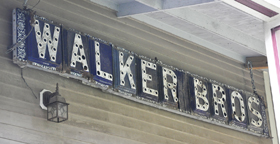 |
| This Walker Brothers Dry Goods store was established in Eureka Springs in 1903. The company opened other stores in Arkansas and Missouri but the Eureka Springs location is gone. This sign which must have come from that store is installed on the porch of a private residence. [map] |
| J.W. Baker Garage [gone] Florence, AZ |
 |
| This Federal Electric sign hung on the backside of the J.W. Baker Garage building. By 2022, the sign was gone. |
| Yreka sign Yreka, CA |
||
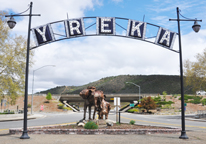 |
 |
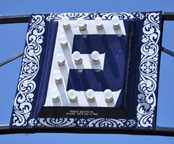 |
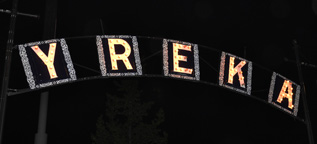 |
| This Yreka sign was built in 1917 for $300. It was originally installed downtown where it spanned a city street. It was strung up on wire between poles on opposite corners of a street downtown. The R and the K letters still have the original metal hangers. The sign was removed during road-widening around 1934 and put in storage. It was restored in 1977 and installed in its current location in a traffic circle. The sign was removed and completely restored in 2019. [map] |
|
More California:
Sequoia Hotel (Redwood City) O'Brien's Candy (San Jose) [vintage; gone] W.A. Haslam (Santa Maria) |
| welcome sign Cañon City, CO |
|
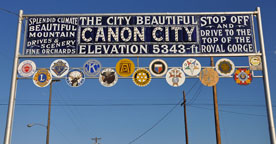 |
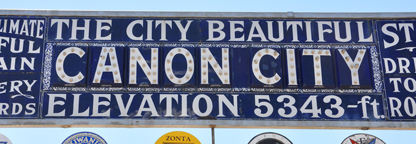 |
| This single-sided welcome sign in Canon City features Federal modular letters at the center. The surrounding panels were also made by Federal Electric. The sign is located next to the Denver and Rio Grande Railroad Depot which is now used as a bank. The depot was built in 1909 and this sign was installed at the same time or very soon after that. It was there by 1911. The panels for the civic organizations were added at some point later on. For more, see this website. [map] |
| Desky Hotel Brush, CO |
 |
| The Desky Hotel operated from 1920-1971. This Federal sign was installed in 1928. It was also single-sided and installed on the side of the building to face the train station across the street. by the mid-1930s, there were neon projecting signs on the front of the building. For more, see these websites: 1 and 2. [map] |
|
More Colorado:
Butte Theatre (Cripple Creek) Sheridan Opera House (Telluride) [map] |
| Newnan/The City of Homes Newnan, GA |
|
 |
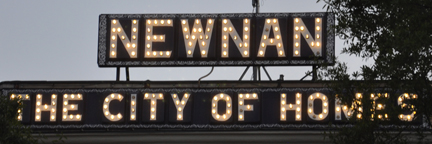 |
| The Newnan/The City of Homes sign was probably installed in the 1910s. It was repainted around 2008. For more, see these websites: 1 and 2. [map] |
| Enders Hotel Soda Springs, ID |
|
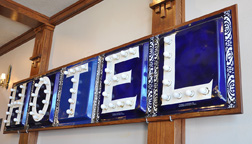 |
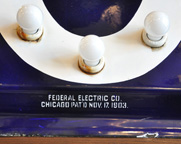 |
| This Federal Electric "Hotel" sign is on display in the cafe inside the Enders Hotel. The hotel was built in 1919 but I don't think this sign was ever displayed on its exterior. |
|
Federal Electric Sectional Signs page 2 |
Main SCA Article Companion Page |
Main Signs Page |
| RoadsideArchitecture.com |
Copyright. All photos at this website are copyrighted and may only be used with my consent. This includes posting them at Facebook, Pinterest, blogs, other websites, personal use, etc. Tips & Updates. If you have suggestions about places that I haven't covered, historical info, or updates about places/things that have been remodeled or removed, I'd love to hear from you: roadarch@outlook.com. |